A Report on Key Factors for Successful ERP Implementation Projects
VerifiedAdded on 2019/11/12
|15
|4118
|185
Report
AI Summary
This report analyzes the critical factors that contribute to successful ERP implementation projects. It begins by highlighting the shift in ERP systems from expensive solutions for large organizations to more accessible options due to cloud computing and modularization, emphasizing the importance of efficient IT systems in the era of globalization and digitalization. The report discusses the importance of selecting an appropriate ERP implementation partner, considering factors beyond cost, and the need to address localized requirements. It also emphasizes the importance of clear project phases, minimizing customizations, and implementing effective testing and training strategies. The report uses case studies, including Mesfine Industrial Engineering (MIE) Pvt. Ltd. and a French multinational's experience in China, to illustrate contrasts between successful and unsuccessful implementations. It covers topics such as go-live strategies, change management, and risk management. The report concludes by emphasizing that organizations can maximize benefits from their ERP investment by carefully considering these factors and tailoring the implementation process to their specific needs.

ERP SYSTEMS: FACTORS CONTRIBUTING TO BEENFIT REALIZATION
ERP Implementation
Student’s name
Name of the Institute
ERP Implementation
Student’s name
Name of the Institute
Paraphrase This Document
Need a fresh take? Get an instant paraphrase of this document with our AI Paraphraser
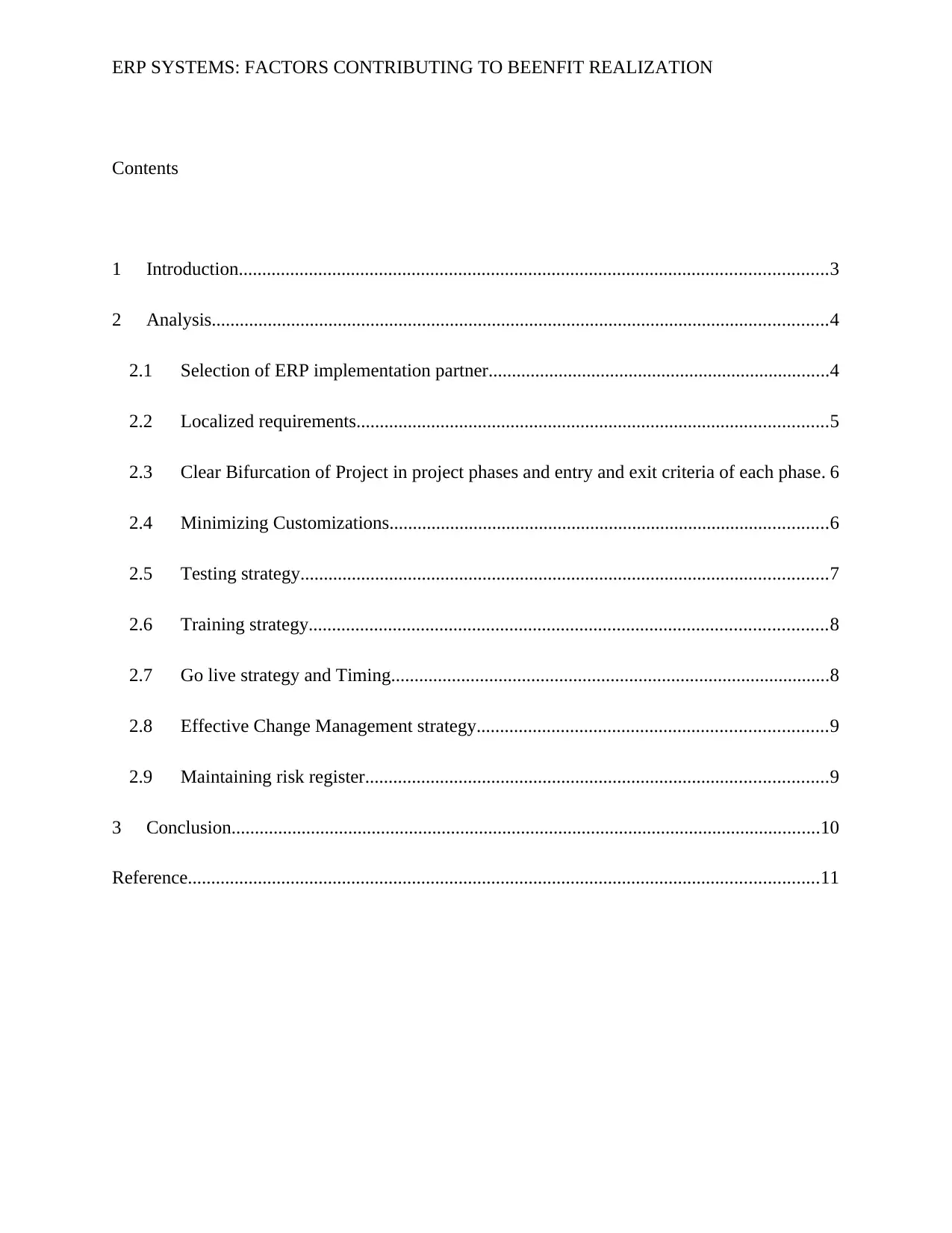
ERP SYSTEMS: FACTORS CONTRIBUTING TO BEENFIT REALIZATION
Contents
1 Introduction..............................................................................................................................3
2 Analysis....................................................................................................................................4
2.1 Selection of ERP implementation partner.........................................................................4
2.2 Localized requirements.....................................................................................................5
2.3 Clear Bifurcation of Project in project phases and entry and exit criteria of each phase. 6
2.4 Minimizing Customizations..............................................................................................6
2.5 Testing strategy.................................................................................................................7
2.6 Training strategy...............................................................................................................8
2.7 Go live strategy and Timing..............................................................................................8
2.8 Effective Change Management strategy...........................................................................9
2.9 Maintaining risk register...................................................................................................9
3 Conclusion..............................................................................................................................10
Reference.......................................................................................................................................11
Contents
1 Introduction..............................................................................................................................3
2 Analysis....................................................................................................................................4
2.1 Selection of ERP implementation partner.........................................................................4
2.2 Localized requirements.....................................................................................................5
2.3 Clear Bifurcation of Project in project phases and entry and exit criteria of each phase. 6
2.4 Minimizing Customizations..............................................................................................6
2.5 Testing strategy.................................................................................................................7
2.6 Training strategy...............................................................................................................8
2.7 Go live strategy and Timing..............................................................................................8
2.8 Effective Change Management strategy...........................................................................9
2.9 Maintaining risk register...................................................................................................9
3 Conclusion..............................................................................................................................10
Reference.......................................................................................................................................11
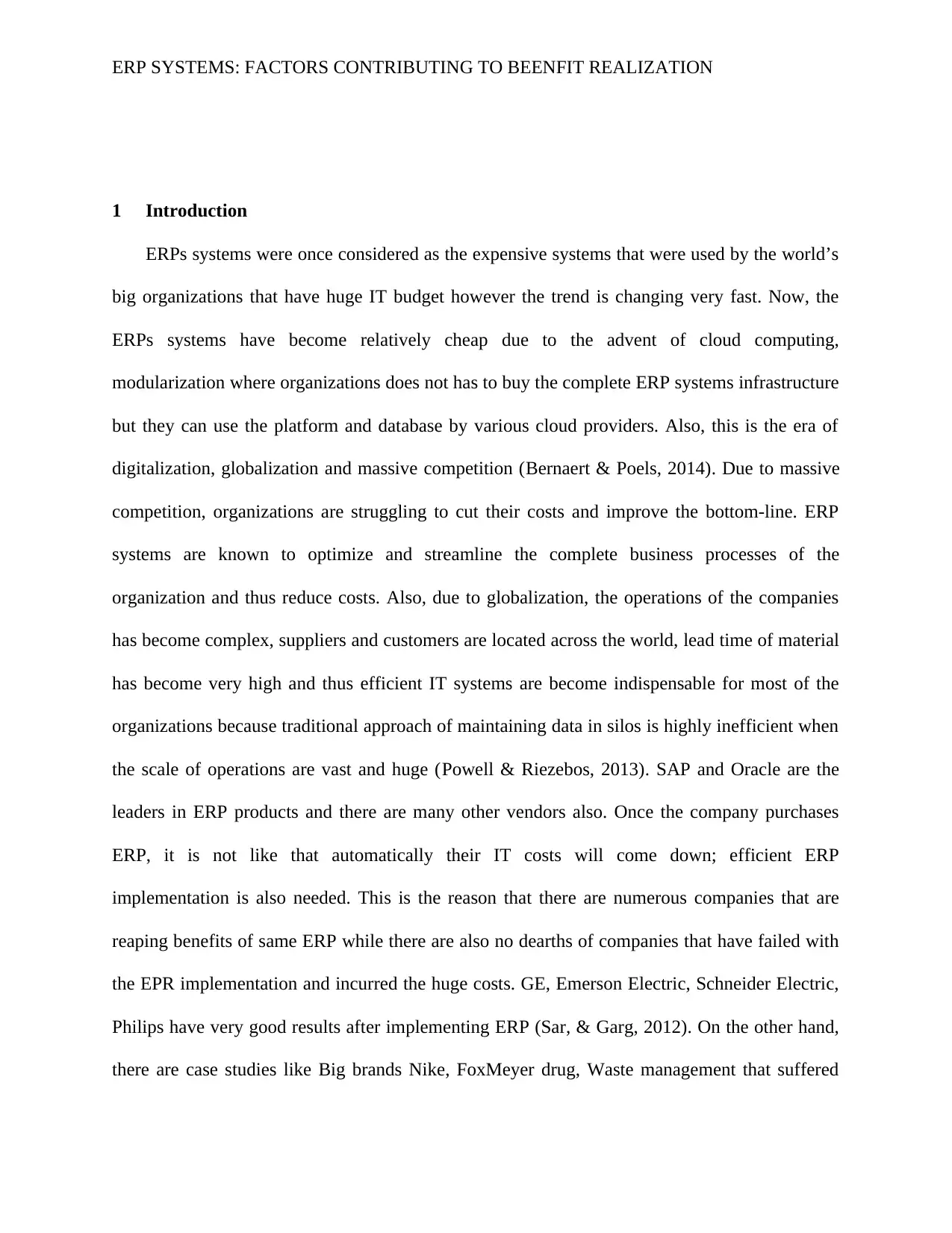
ERP SYSTEMS: FACTORS CONTRIBUTING TO BEENFIT REALIZATION
1 Introduction
ERPs systems were once considered as the expensive systems that were used by the world’s
big organizations that have huge IT budget however the trend is changing very fast. Now, the
ERPs systems have become relatively cheap due to the advent of cloud computing,
modularization where organizations does not has to buy the complete ERP systems infrastructure
but they can use the platform and database by various cloud providers. Also, this is the era of
digitalization, globalization and massive competition (Bernaert & Poels, 2014). Due to massive
competition, organizations are struggling to cut their costs and improve the bottom-line. ERP
systems are known to optimize and streamline the complete business processes of the
organization and thus reduce costs. Also, due to globalization, the operations of the companies
has become complex, suppliers and customers are located across the world, lead time of material
has become very high and thus efficient IT systems are become indispensable for most of the
organizations because traditional approach of maintaining data in silos is highly inefficient when
the scale of operations are vast and huge (Powell & Riezebos, 2013). SAP and Oracle are the
leaders in ERP products and there are many other vendors also. Once the company purchases
ERP, it is not like that automatically their IT costs will come down; efficient ERP
implementation is also needed. This is the reason that there are numerous companies that are
reaping benefits of same ERP while there are also no dearths of companies that have failed with
the EPR implementation and incurred the huge costs. GE, Emerson Electric, Schneider Electric,
Philips have very good results after implementing ERP (Sar, & Garg, 2012). On the other hand,
there are case studies like Big brands Nike, FoxMeyer drug, Waste management that suffered
1 Introduction
ERPs systems were once considered as the expensive systems that were used by the world’s
big organizations that have huge IT budget however the trend is changing very fast. Now, the
ERPs systems have become relatively cheap due to the advent of cloud computing,
modularization where organizations does not has to buy the complete ERP systems infrastructure
but they can use the platform and database by various cloud providers. Also, this is the era of
digitalization, globalization and massive competition (Bernaert & Poels, 2014). Due to massive
competition, organizations are struggling to cut their costs and improve the bottom-line. ERP
systems are known to optimize and streamline the complete business processes of the
organization and thus reduce costs. Also, due to globalization, the operations of the companies
has become complex, suppliers and customers are located across the world, lead time of material
has become very high and thus efficient IT systems are become indispensable for most of the
organizations because traditional approach of maintaining data in silos is highly inefficient when
the scale of operations are vast and huge (Powell & Riezebos, 2013). SAP and Oracle are the
leaders in ERP products and there are many other vendors also. Once the company purchases
ERP, it is not like that automatically their IT costs will come down; efficient ERP
implementation is also needed. This is the reason that there are numerous companies that are
reaping benefits of same ERP while there are also no dearths of companies that have failed with
the EPR implementation and incurred the huge costs. GE, Emerson Electric, Schneider Electric,
Philips have very good results after implementing ERP (Sar, & Garg, 2012). On the other hand,
there are case studies like Big brands Nike, FoxMeyer drug, Waste management that suffered
⊘ This is a preview!⊘
Do you want full access?
Subscribe today to unlock all pages.

Trusted by 1+ million students worldwide
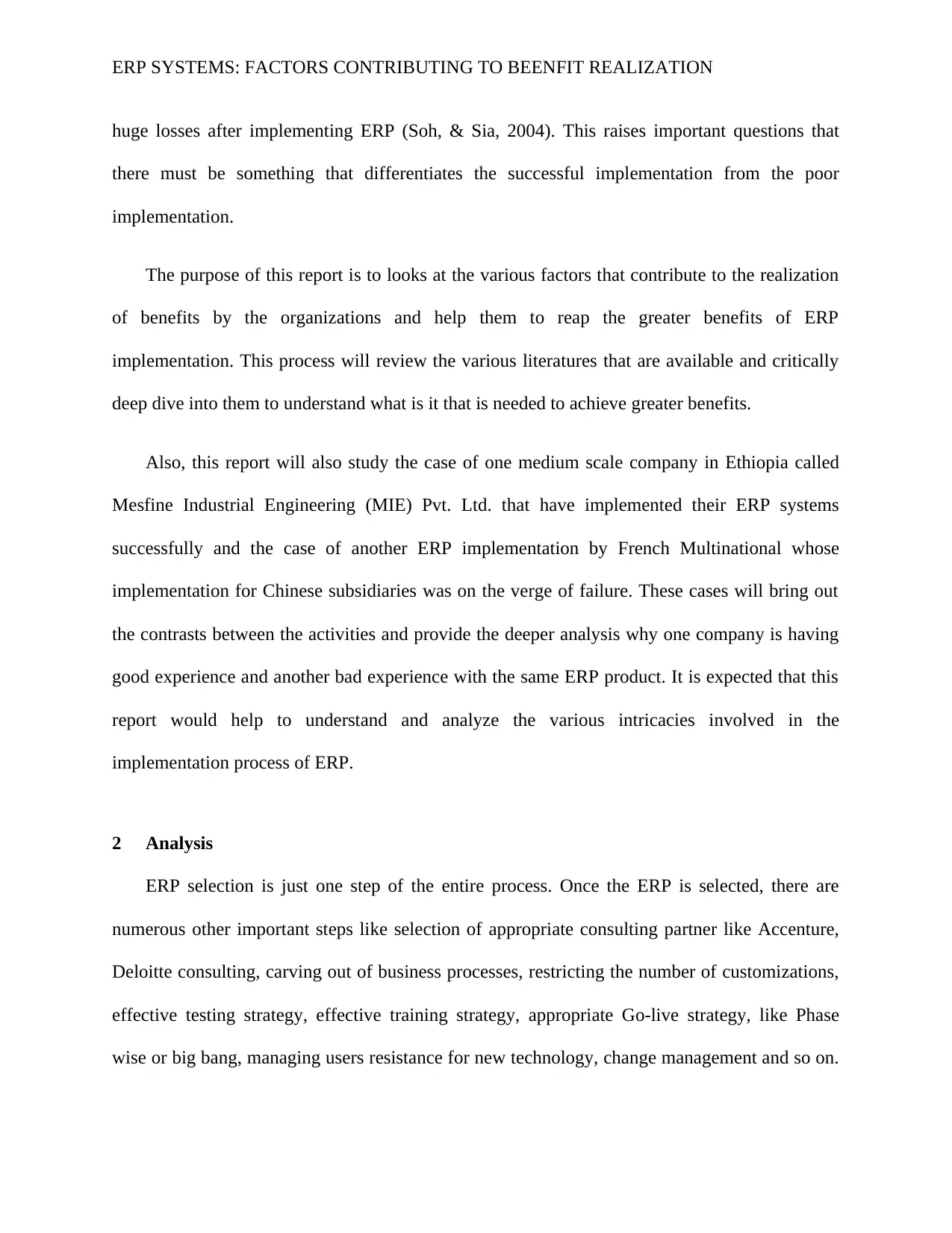
ERP SYSTEMS: FACTORS CONTRIBUTING TO BEENFIT REALIZATION
huge losses after implementing ERP (Soh, & Sia, 2004). This raises important questions that
there must be something that differentiates the successful implementation from the poor
implementation.
The purpose of this report is to looks at the various factors that contribute to the realization
of benefits by the organizations and help them to reap the greater benefits of ERP
implementation. This process will review the various literatures that are available and critically
deep dive into them to understand what is it that is needed to achieve greater benefits.
Also, this report will also study the case of one medium scale company in Ethiopia called
Mesfine Industrial Engineering (MIE) Pvt. Ltd. that have implemented their ERP systems
successfully and the case of another ERP implementation by French Multinational whose
implementation for Chinese subsidiaries was on the verge of failure. These cases will bring out
the contrasts between the activities and provide the deeper analysis why one company is having
good experience and another bad experience with the same ERP product. It is expected that this
report would help to understand and analyze the various intricacies involved in the
implementation process of ERP.
2 Analysis
ERP selection is just one step of the entire process. Once the ERP is selected, there are
numerous other important steps like selection of appropriate consulting partner like Accenture,
Deloitte consulting, carving out of business processes, restricting the number of customizations,
effective testing strategy, effective training strategy, appropriate Go-live strategy, like Phase
wise or big bang, managing users resistance for new technology, change management and so on.
huge losses after implementing ERP (Soh, & Sia, 2004). This raises important questions that
there must be something that differentiates the successful implementation from the poor
implementation.
The purpose of this report is to looks at the various factors that contribute to the realization
of benefits by the organizations and help them to reap the greater benefits of ERP
implementation. This process will review the various literatures that are available and critically
deep dive into them to understand what is it that is needed to achieve greater benefits.
Also, this report will also study the case of one medium scale company in Ethiopia called
Mesfine Industrial Engineering (MIE) Pvt. Ltd. that have implemented their ERP systems
successfully and the case of another ERP implementation by French Multinational whose
implementation for Chinese subsidiaries was on the verge of failure. These cases will bring out
the contrasts between the activities and provide the deeper analysis why one company is having
good experience and another bad experience with the same ERP product. It is expected that this
report would help to understand and analyze the various intricacies involved in the
implementation process of ERP.
2 Analysis
ERP selection is just one step of the entire process. Once the ERP is selected, there are
numerous other important steps like selection of appropriate consulting partner like Accenture,
Deloitte consulting, carving out of business processes, restricting the number of customizations,
effective testing strategy, effective training strategy, appropriate Go-live strategy, like Phase
wise or big bang, managing users resistance for new technology, change management and so on.
Paraphrase This Document
Need a fresh take? Get an instant paraphrase of this document with our AI Paraphraser
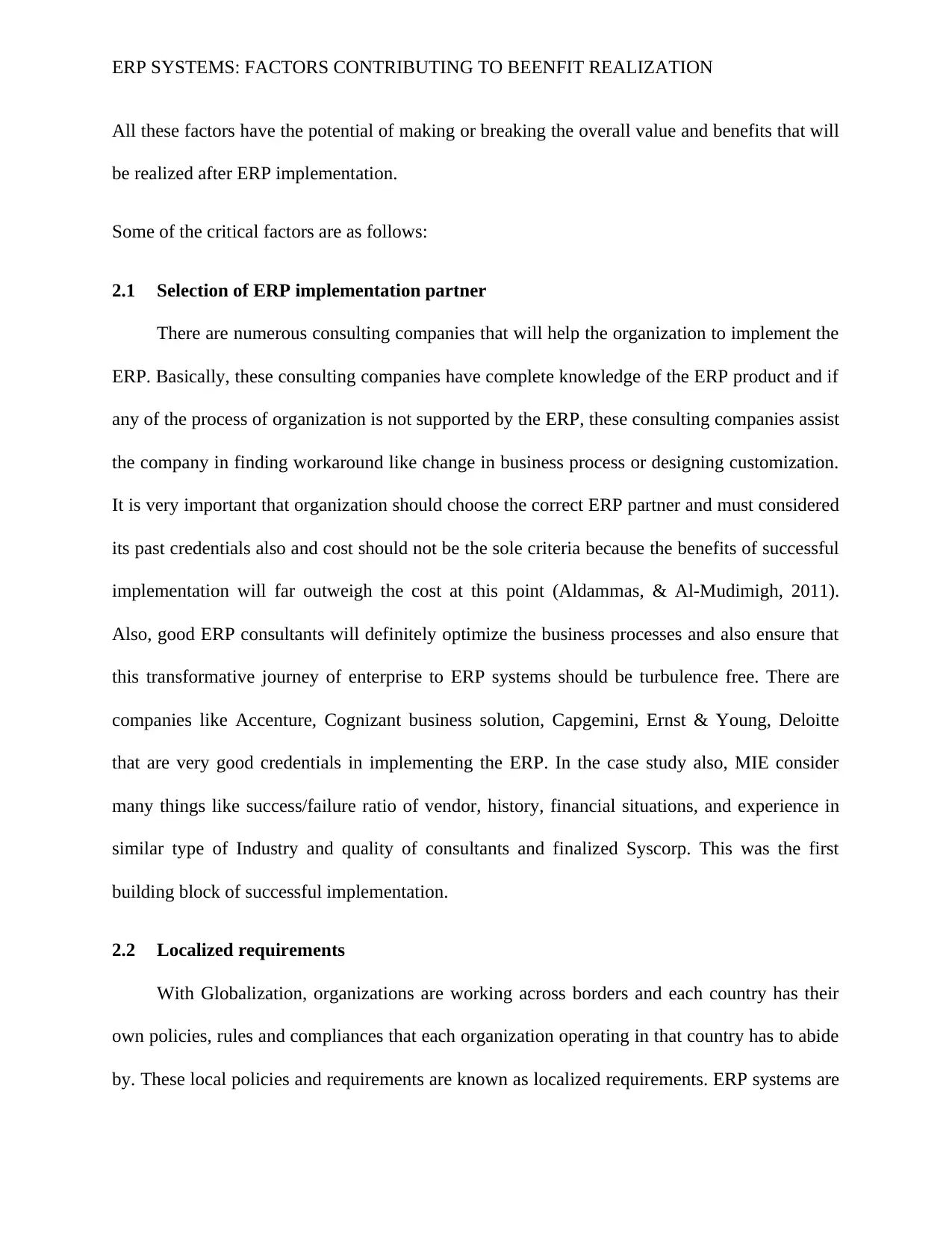
ERP SYSTEMS: FACTORS CONTRIBUTING TO BEENFIT REALIZATION
All these factors have the potential of making or breaking the overall value and benefits that will
be realized after ERP implementation.
Some of the critical factors are as follows:
2.1 Selection of ERP implementation partner
There are numerous consulting companies that will help the organization to implement the
ERP. Basically, these consulting companies have complete knowledge of the ERP product and if
any of the process of organization is not supported by the ERP, these consulting companies assist
the company in finding workaround like change in business process or designing customization.
It is very important that organization should choose the correct ERP partner and must considered
its past credentials also and cost should not be the sole criteria because the benefits of successful
implementation will far outweigh the cost at this point (Aldammas, & Al-Mudimigh, 2011).
Also, good ERP consultants will definitely optimize the business processes and also ensure that
this transformative journey of enterprise to ERP systems should be turbulence free. There are
companies like Accenture, Cognizant business solution, Capgemini, Ernst & Young, Deloitte
that are very good credentials in implementing the ERP. In the case study also, MIE consider
many things like success/failure ratio of vendor, history, financial situations, and experience in
similar type of Industry and quality of consultants and finalized Syscorp. This was the first
building block of successful implementation.
2.2 Localized requirements
With Globalization, organizations are working across borders and each country has their
own policies, rules and compliances that each organization operating in that country has to abide
by. These local policies and requirements are known as localized requirements. ERP systems are
All these factors have the potential of making or breaking the overall value and benefits that will
be realized after ERP implementation.
Some of the critical factors are as follows:
2.1 Selection of ERP implementation partner
There are numerous consulting companies that will help the organization to implement the
ERP. Basically, these consulting companies have complete knowledge of the ERP product and if
any of the process of organization is not supported by the ERP, these consulting companies assist
the company in finding workaround like change in business process or designing customization.
It is very important that organization should choose the correct ERP partner and must considered
its past credentials also and cost should not be the sole criteria because the benefits of successful
implementation will far outweigh the cost at this point (Aldammas, & Al-Mudimigh, 2011).
Also, good ERP consultants will definitely optimize the business processes and also ensure that
this transformative journey of enterprise to ERP systems should be turbulence free. There are
companies like Accenture, Cognizant business solution, Capgemini, Ernst & Young, Deloitte
that are very good credentials in implementing the ERP. In the case study also, MIE consider
many things like success/failure ratio of vendor, history, financial situations, and experience in
similar type of Industry and quality of consultants and finalized Syscorp. This was the first
building block of successful implementation.
2.2 Localized requirements
With Globalization, organizations are working across borders and each country has their
own policies, rules and compliances that each organization operating in that country has to abide
by. These local policies and requirements are known as localized requirements. ERP systems are
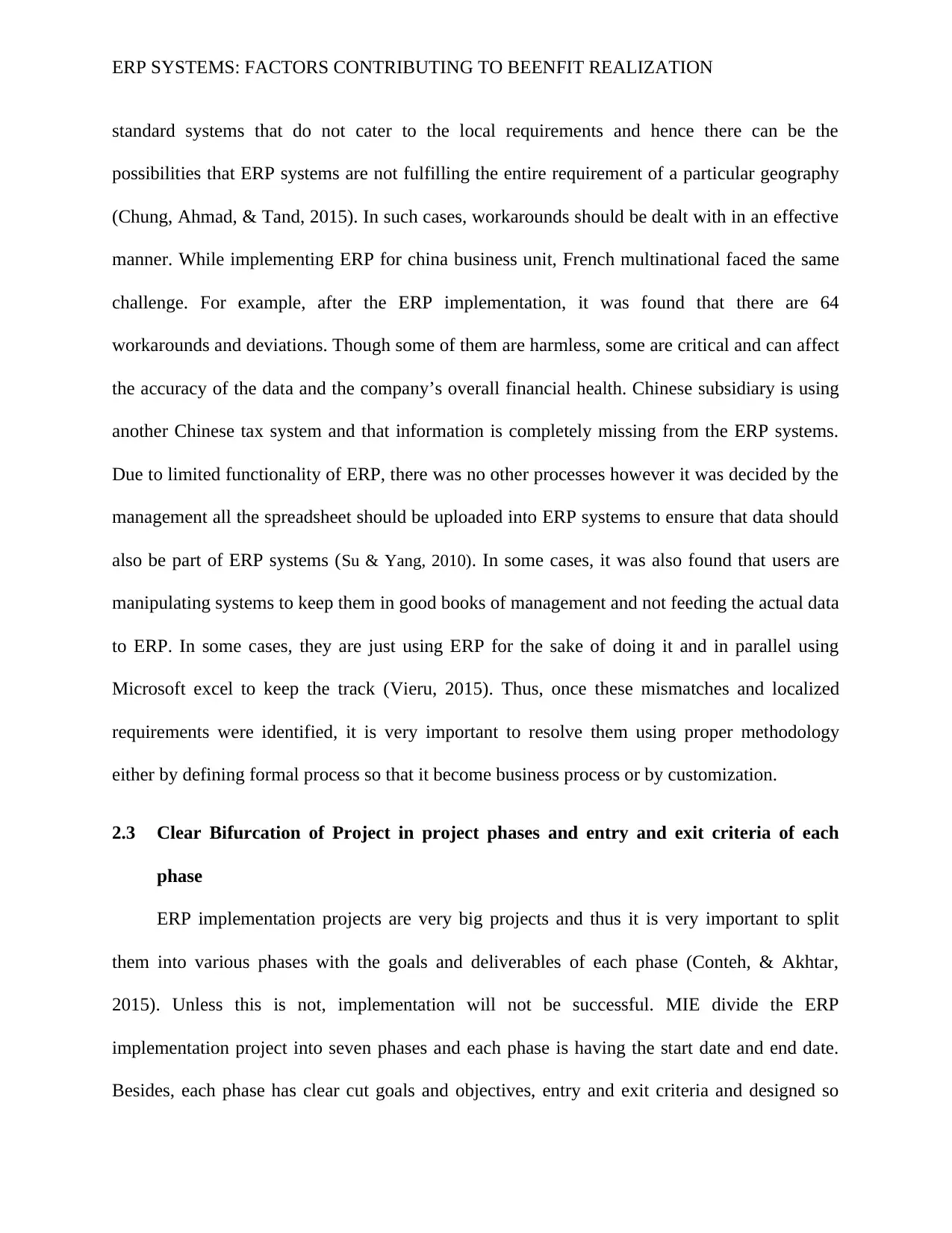
ERP SYSTEMS: FACTORS CONTRIBUTING TO BEENFIT REALIZATION
standard systems that do not cater to the local requirements and hence there can be the
possibilities that ERP systems are not fulfilling the entire requirement of a particular geography
(Chung, Ahmad, & Tand, 2015). In such cases, workarounds should be dealt with in an effective
manner. While implementing ERP for china business unit, French multinational faced the same
challenge. For example, after the ERP implementation, it was found that there are 64
workarounds and deviations. Though some of them are harmless, some are critical and can affect
the accuracy of the data and the company’s overall financial health. Chinese subsidiary is using
another Chinese tax system and that information is completely missing from the ERP systems.
Due to limited functionality of ERP, there was no other processes however it was decided by the
management all the spreadsheet should be uploaded into ERP systems to ensure that data should
also be part of ERP systems (Su & Yang, 2010). In some cases, it was also found that users are
manipulating systems to keep them in good books of management and not feeding the actual data
to ERP. In some cases, they are just using ERP for the sake of doing it and in parallel using
Microsoft excel to keep the track (Vieru, 2015). Thus, once these mismatches and localized
requirements were identified, it is very important to resolve them using proper methodology
either by defining formal process so that it become business process or by customization.
2.3 Clear Bifurcation of Project in project phases and entry and exit criteria of each
phase
ERP implementation projects are very big projects and thus it is very important to split
them into various phases with the goals and deliverables of each phase (Conteh, & Akhtar,
2015). Unless this is not, implementation will not be successful. MIE divide the ERP
implementation project into seven phases and each phase is having the start date and end date.
Besides, each phase has clear cut goals and objectives, entry and exit criteria and designed so
standard systems that do not cater to the local requirements and hence there can be the
possibilities that ERP systems are not fulfilling the entire requirement of a particular geography
(Chung, Ahmad, & Tand, 2015). In such cases, workarounds should be dealt with in an effective
manner. While implementing ERP for china business unit, French multinational faced the same
challenge. For example, after the ERP implementation, it was found that there are 64
workarounds and deviations. Though some of them are harmless, some are critical and can affect
the accuracy of the data and the company’s overall financial health. Chinese subsidiary is using
another Chinese tax system and that information is completely missing from the ERP systems.
Due to limited functionality of ERP, there was no other processes however it was decided by the
management all the spreadsheet should be uploaded into ERP systems to ensure that data should
also be part of ERP systems (Su & Yang, 2010). In some cases, it was also found that users are
manipulating systems to keep them in good books of management and not feeding the actual data
to ERP. In some cases, they are just using ERP for the sake of doing it and in parallel using
Microsoft excel to keep the track (Vieru, 2015). Thus, once these mismatches and localized
requirements were identified, it is very important to resolve them using proper methodology
either by defining formal process so that it become business process or by customization.
2.3 Clear Bifurcation of Project in project phases and entry and exit criteria of each
phase
ERP implementation projects are very big projects and thus it is very important to split
them into various phases with the goals and deliverables of each phase (Conteh, & Akhtar,
2015). Unless this is not, implementation will not be successful. MIE divide the ERP
implementation project into seven phases and each phase is having the start date and end date.
Besides, each phase has clear cut goals and objectives, entry and exit criteria and designed so
⊘ This is a preview!⊘
Do you want full access?
Subscribe today to unlock all pages.

Trusted by 1+ million students worldwide
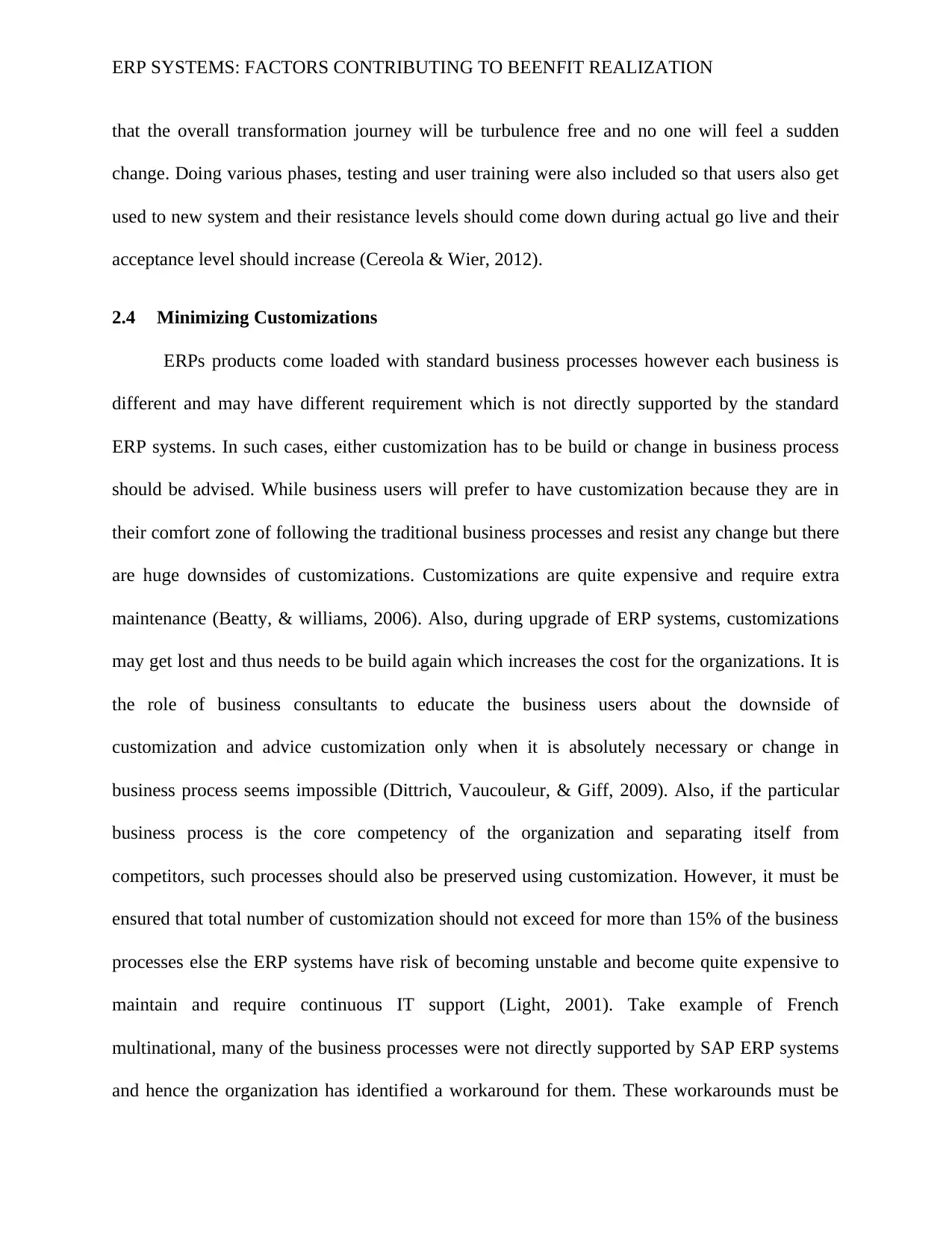
ERP SYSTEMS: FACTORS CONTRIBUTING TO BEENFIT REALIZATION
that the overall transformation journey will be turbulence free and no one will feel a sudden
change. Doing various phases, testing and user training were also included so that users also get
used to new system and their resistance levels should come down during actual go live and their
acceptance level should increase (Cereola & Wier, 2012).
2.4 Minimizing Customizations
ERPs products come loaded with standard business processes however each business is
different and may have different requirement which is not directly supported by the standard
ERP systems. In such cases, either customization has to be build or change in business process
should be advised. While business users will prefer to have customization because they are in
their comfort zone of following the traditional business processes and resist any change but there
are huge downsides of customizations. Customizations are quite expensive and require extra
maintenance (Beatty, & williams, 2006). Also, during upgrade of ERP systems, customizations
may get lost and thus needs to be build again which increases the cost for the organizations. It is
the role of business consultants to educate the business users about the downside of
customization and advice customization only when it is absolutely necessary or change in
business process seems impossible (Dittrich, Vaucouleur, & Giff, 2009). Also, if the particular
business process is the core competency of the organization and separating itself from
competitors, such processes should also be preserved using customization. However, it must be
ensured that total number of customization should not exceed for more than 15% of the business
processes else the ERP systems have risk of becoming unstable and become quite expensive to
maintain and require continuous IT support (Light, 2001). Take example of French
multinational, many of the business processes were not directly supported by SAP ERP systems
and hence the organization has identified a workaround for them. These workarounds must be
that the overall transformation journey will be turbulence free and no one will feel a sudden
change. Doing various phases, testing and user training were also included so that users also get
used to new system and their resistance levels should come down during actual go live and their
acceptance level should increase (Cereola & Wier, 2012).
2.4 Minimizing Customizations
ERPs products come loaded with standard business processes however each business is
different and may have different requirement which is not directly supported by the standard
ERP systems. In such cases, either customization has to be build or change in business process
should be advised. While business users will prefer to have customization because they are in
their comfort zone of following the traditional business processes and resist any change but there
are huge downsides of customizations. Customizations are quite expensive and require extra
maintenance (Beatty, & williams, 2006). Also, during upgrade of ERP systems, customizations
may get lost and thus needs to be build again which increases the cost for the organizations. It is
the role of business consultants to educate the business users about the downside of
customization and advice customization only when it is absolutely necessary or change in
business process seems impossible (Dittrich, Vaucouleur, & Giff, 2009). Also, if the particular
business process is the core competency of the organization and separating itself from
competitors, such processes should also be preserved using customization. However, it must be
ensured that total number of customization should not exceed for more than 15% of the business
processes else the ERP systems have risk of becoming unstable and become quite expensive to
maintain and require continuous IT support (Light, 2001). Take example of French
multinational, many of the business processes were not directly supported by SAP ERP systems
and hence the organization has identified a workaround for them. These workarounds must be
Paraphrase This Document
Need a fresh take? Get an instant paraphrase of this document with our AI Paraphraser
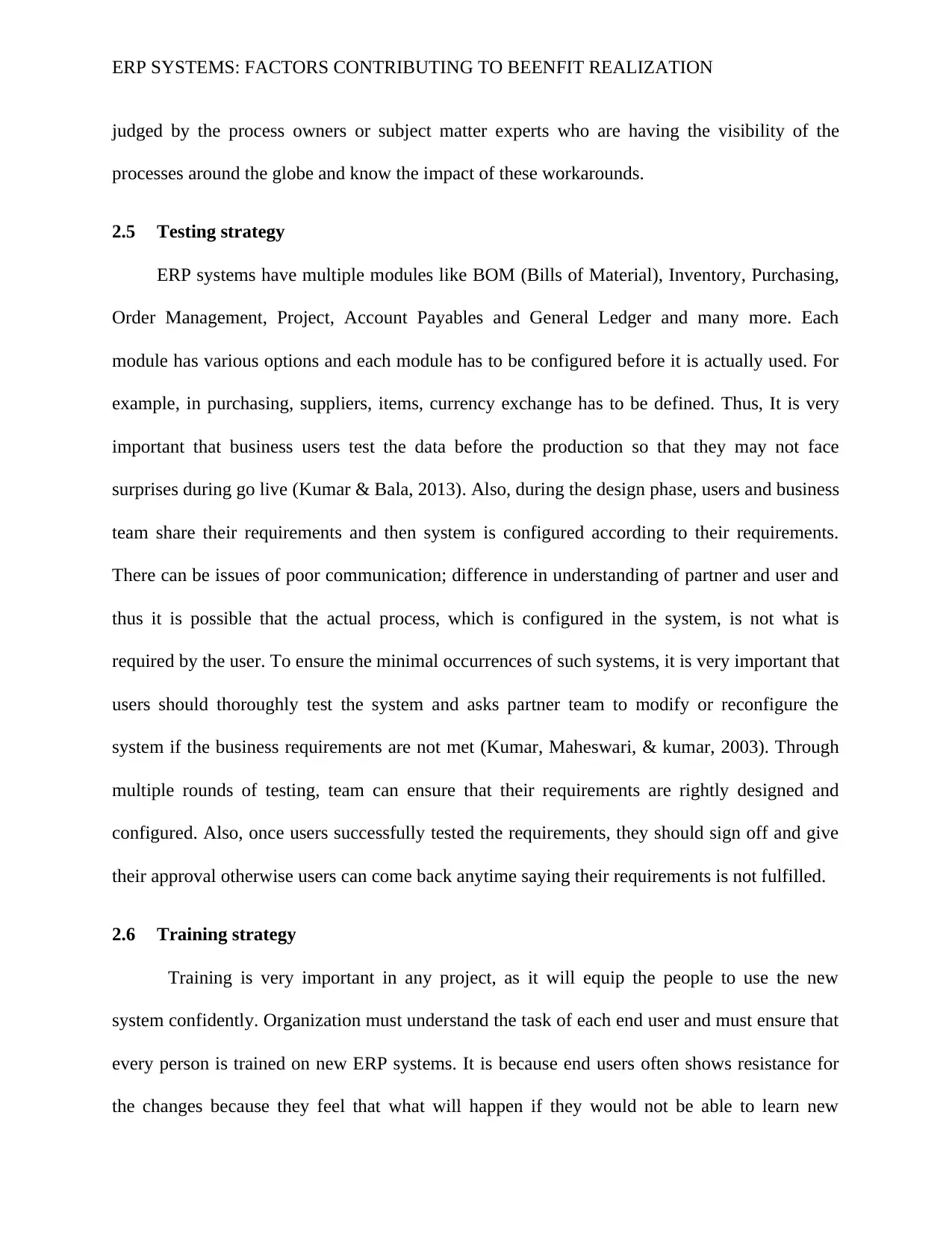
ERP SYSTEMS: FACTORS CONTRIBUTING TO BEENFIT REALIZATION
judged by the process owners or subject matter experts who are having the visibility of the
processes around the globe and know the impact of these workarounds.
2.5 Testing strategy
ERP systems have multiple modules like BOM (Bills of Material), Inventory, Purchasing,
Order Management, Project, Account Payables and General Ledger and many more. Each
module has various options and each module has to be configured before it is actually used. For
example, in purchasing, suppliers, items, currency exchange has to be defined. Thus, It is very
important that business users test the data before the production so that they may not face
surprises during go live (Kumar & Bala, 2013). Also, during the design phase, users and business
team share their requirements and then system is configured according to their requirements.
There can be issues of poor communication; difference in understanding of partner and user and
thus it is possible that the actual process, which is configured in the system, is not what is
required by the user. To ensure the minimal occurrences of such systems, it is very important that
users should thoroughly test the system and asks partner team to modify or reconfigure the
system if the business requirements are not met (Kumar, Maheswari, & kumar, 2003). Through
multiple rounds of testing, team can ensure that their requirements are rightly designed and
configured. Also, once users successfully tested the requirements, they should sign off and give
their approval otherwise users can come back anytime saying their requirements is not fulfilled.
2.6 Training strategy
Training is very important in any project, as it will equip the people to use the new
system confidently. Organization must understand the task of each end user and must ensure that
every person is trained on new ERP systems. It is because end users often shows resistance for
the changes because they feel that what will happen if they would not be able to learn new
judged by the process owners or subject matter experts who are having the visibility of the
processes around the globe and know the impact of these workarounds.
2.5 Testing strategy
ERP systems have multiple modules like BOM (Bills of Material), Inventory, Purchasing,
Order Management, Project, Account Payables and General Ledger and many more. Each
module has various options and each module has to be configured before it is actually used. For
example, in purchasing, suppliers, items, currency exchange has to be defined. Thus, It is very
important that business users test the data before the production so that they may not face
surprises during go live (Kumar & Bala, 2013). Also, during the design phase, users and business
team share their requirements and then system is configured according to their requirements.
There can be issues of poor communication; difference in understanding of partner and user and
thus it is possible that the actual process, which is configured in the system, is not what is
required by the user. To ensure the minimal occurrences of such systems, it is very important that
users should thoroughly test the system and asks partner team to modify or reconfigure the
system if the business requirements are not met (Kumar, Maheswari, & kumar, 2003). Through
multiple rounds of testing, team can ensure that their requirements are rightly designed and
configured. Also, once users successfully tested the requirements, they should sign off and give
their approval otherwise users can come back anytime saying their requirements is not fulfilled.
2.6 Training strategy
Training is very important in any project, as it will equip the people to use the new
system confidently. Organization must understand the task of each end user and must ensure that
every person is trained on new ERP systems. It is because end users often shows resistance for
the changes because they feel that what will happen if they would not be able to learn new
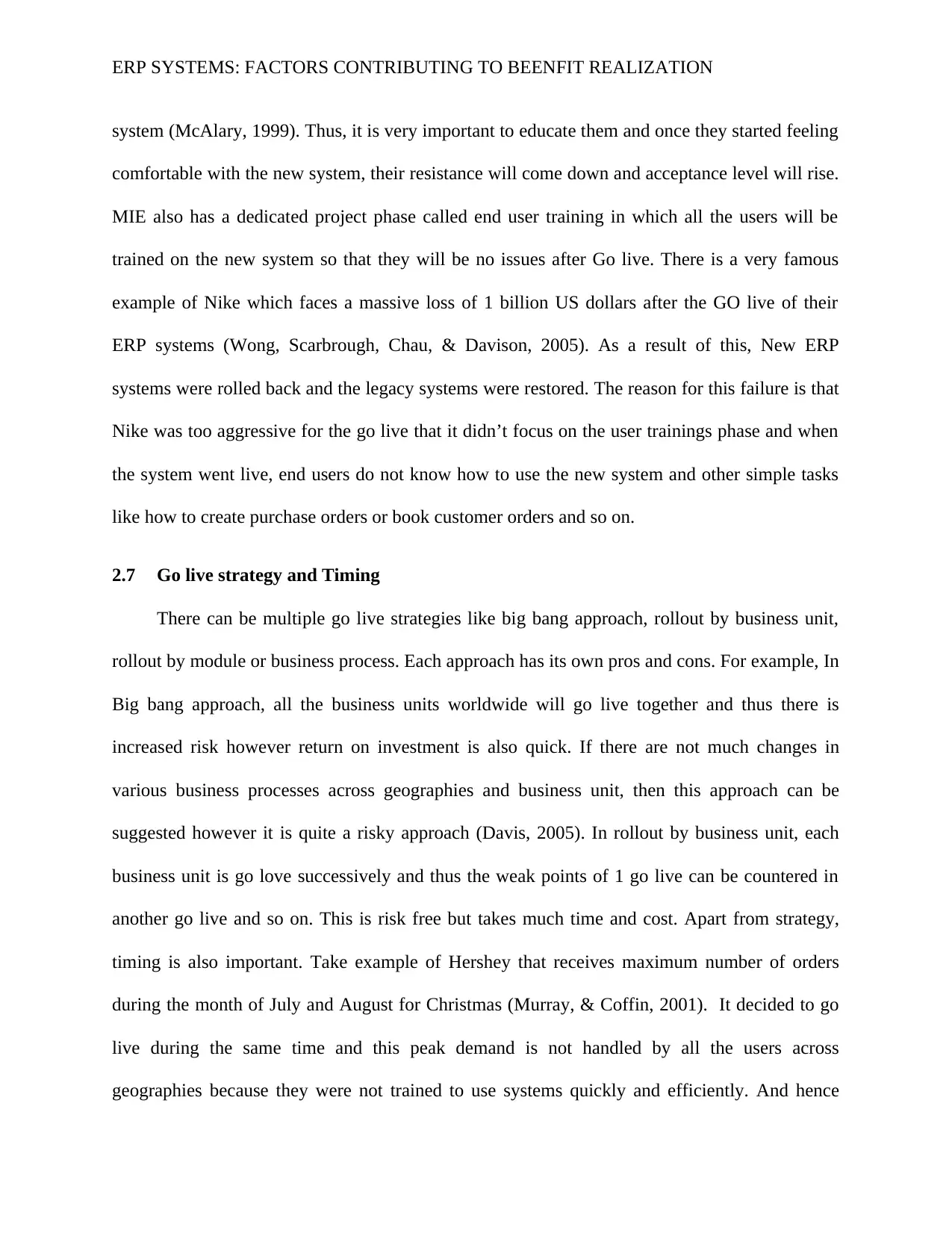
ERP SYSTEMS: FACTORS CONTRIBUTING TO BEENFIT REALIZATION
system (McAlary, 1999). Thus, it is very important to educate them and once they started feeling
comfortable with the new system, their resistance will come down and acceptance level will rise.
MIE also has a dedicated project phase called end user training in which all the users will be
trained on the new system so that they will be no issues after Go live. There is a very famous
example of Nike which faces a massive loss of 1 billion US dollars after the GO live of their
ERP systems (Wong, Scarbrough, Chau, & Davison, 2005). As a result of this, New ERP
systems were rolled back and the legacy systems were restored. The reason for this failure is that
Nike was too aggressive for the go live that it didn’t focus on the user trainings phase and when
the system went live, end users do not know how to use the new system and other simple tasks
like how to create purchase orders or book customer orders and so on.
2.7 Go live strategy and Timing
There can be multiple go live strategies like big bang approach, rollout by business unit,
rollout by module or business process. Each approach has its own pros and cons. For example, In
Big bang approach, all the business units worldwide will go live together and thus there is
increased risk however return on investment is also quick. If there are not much changes in
various business processes across geographies and business unit, then this approach can be
suggested however it is quite a risky approach (Davis, 2005). In rollout by business unit, each
business unit is go love successively and thus the weak points of 1 go live can be countered in
another go live and so on. This is risk free but takes much time and cost. Apart from strategy,
timing is also important. Take example of Hershey that receives maximum number of orders
during the month of July and August for Christmas (Murray, & Coffin, 2001). It decided to go
live during the same time and this peak demand is not handled by all the users across
geographies because they were not trained to use systems quickly and efficiently. And hence
system (McAlary, 1999). Thus, it is very important to educate them and once they started feeling
comfortable with the new system, their resistance will come down and acceptance level will rise.
MIE also has a dedicated project phase called end user training in which all the users will be
trained on the new system so that they will be no issues after Go live. There is a very famous
example of Nike which faces a massive loss of 1 billion US dollars after the GO live of their
ERP systems (Wong, Scarbrough, Chau, & Davison, 2005). As a result of this, New ERP
systems were rolled back and the legacy systems were restored. The reason for this failure is that
Nike was too aggressive for the go live that it didn’t focus on the user trainings phase and when
the system went live, end users do not know how to use the new system and other simple tasks
like how to create purchase orders or book customer orders and so on.
2.7 Go live strategy and Timing
There can be multiple go live strategies like big bang approach, rollout by business unit,
rollout by module or business process. Each approach has its own pros and cons. For example, In
Big bang approach, all the business units worldwide will go live together and thus there is
increased risk however return on investment is also quick. If there are not much changes in
various business processes across geographies and business unit, then this approach can be
suggested however it is quite a risky approach (Davis, 2005). In rollout by business unit, each
business unit is go love successively and thus the weak points of 1 go live can be countered in
another go live and so on. This is risk free but takes much time and cost. Apart from strategy,
timing is also important. Take example of Hershey that receives maximum number of orders
during the month of July and August for Christmas (Murray, & Coffin, 2001). It decided to go
live during the same time and this peak demand is not handled by all the users across
geographies because they were not trained to use systems quickly and efficiently. And hence
⊘ This is a preview!⊘
Do you want full access?
Subscribe today to unlock all pages.

Trusted by 1+ million students worldwide
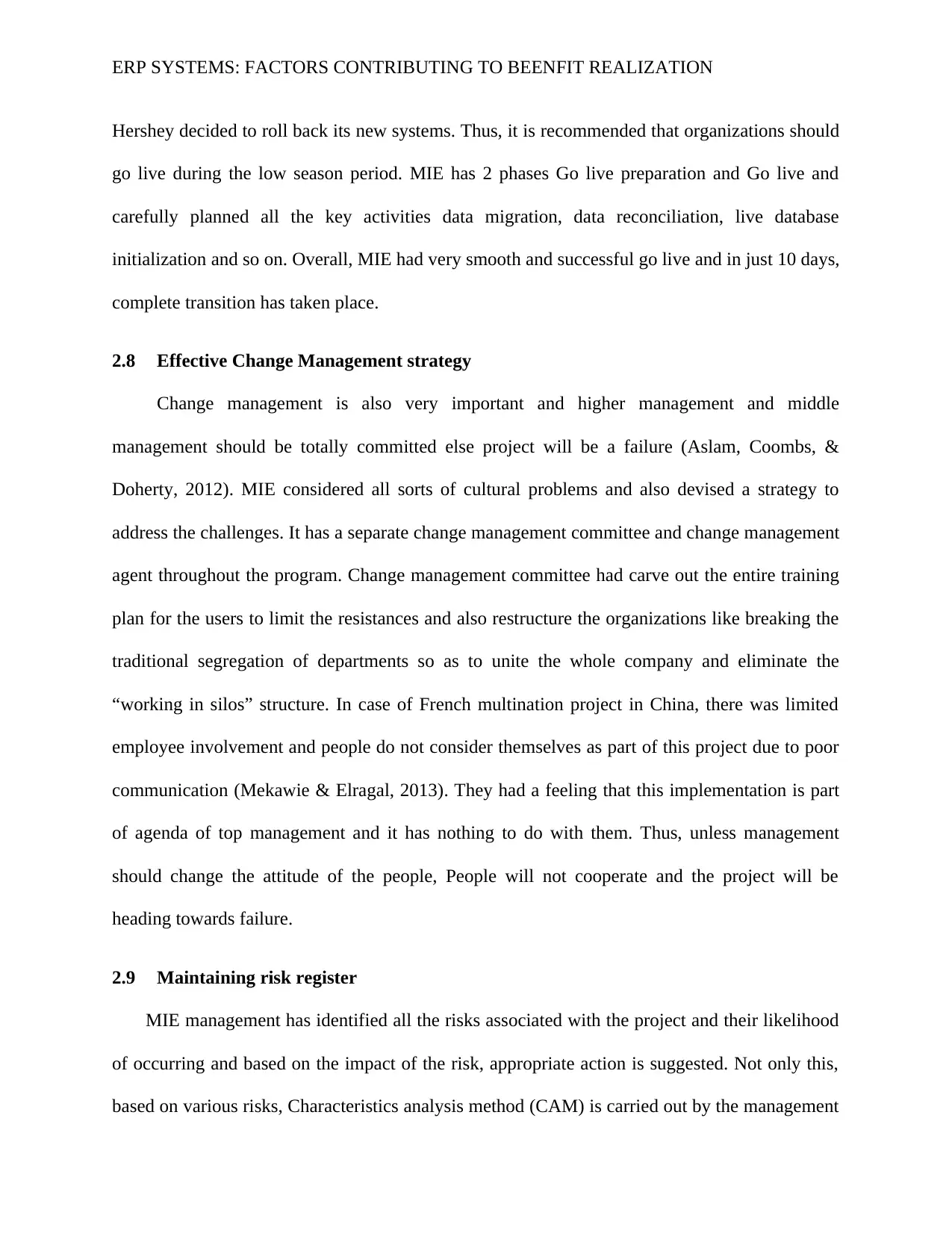
ERP SYSTEMS: FACTORS CONTRIBUTING TO BEENFIT REALIZATION
Hershey decided to roll back its new systems. Thus, it is recommended that organizations should
go live during the low season period. MIE has 2 phases Go live preparation and Go live and
carefully planned all the key activities data migration, data reconciliation, live database
initialization and so on. Overall, MIE had very smooth and successful go live and in just 10 days,
complete transition has taken place.
2.8 Effective Change Management strategy
Change management is also very important and higher management and middle
management should be totally committed else project will be a failure (Aslam, Coombs, &
Doherty, 2012). MIE considered all sorts of cultural problems and also devised a strategy to
address the challenges. It has a separate change management committee and change management
agent throughout the program. Change management committee had carve out the entire training
plan for the users to limit the resistances and also restructure the organizations like breaking the
traditional segregation of departments so as to unite the whole company and eliminate the
“working in silos” structure. In case of French multination project in China, there was limited
employee involvement and people do not consider themselves as part of this project due to poor
communication (Mekawie & Elragal, 2013). They had a feeling that this implementation is part
of agenda of top management and it has nothing to do with them. Thus, unless management
should change the attitude of the people, People will not cooperate and the project will be
heading towards failure.
2.9 Maintaining risk register
MIE management has identified all the risks associated with the project and their likelihood
of occurring and based on the impact of the risk, appropriate action is suggested. Not only this,
based on various risks, Characteristics analysis method (CAM) is carried out by the management
Hershey decided to roll back its new systems. Thus, it is recommended that organizations should
go live during the low season period. MIE has 2 phases Go live preparation and Go live and
carefully planned all the key activities data migration, data reconciliation, live database
initialization and so on. Overall, MIE had very smooth and successful go live and in just 10 days,
complete transition has taken place.
2.8 Effective Change Management strategy
Change management is also very important and higher management and middle
management should be totally committed else project will be a failure (Aslam, Coombs, &
Doherty, 2012). MIE considered all sorts of cultural problems and also devised a strategy to
address the challenges. It has a separate change management committee and change management
agent throughout the program. Change management committee had carve out the entire training
plan for the users to limit the resistances and also restructure the organizations like breaking the
traditional segregation of departments so as to unite the whole company and eliminate the
“working in silos” structure. In case of French multination project in China, there was limited
employee involvement and people do not consider themselves as part of this project due to poor
communication (Mekawie & Elragal, 2013). They had a feeling that this implementation is part
of agenda of top management and it has nothing to do with them. Thus, unless management
should change the attitude of the people, People will not cooperate and the project will be
heading towards failure.
2.9 Maintaining risk register
MIE management has identified all the risks associated with the project and their likelihood
of occurring and based on the impact of the risk, appropriate action is suggested. Not only this,
based on various risks, Characteristics analysis method (CAM) is carried out by the management
Paraphrase This Document
Need a fresh take? Get an instant paraphrase of this document with our AI Paraphraser
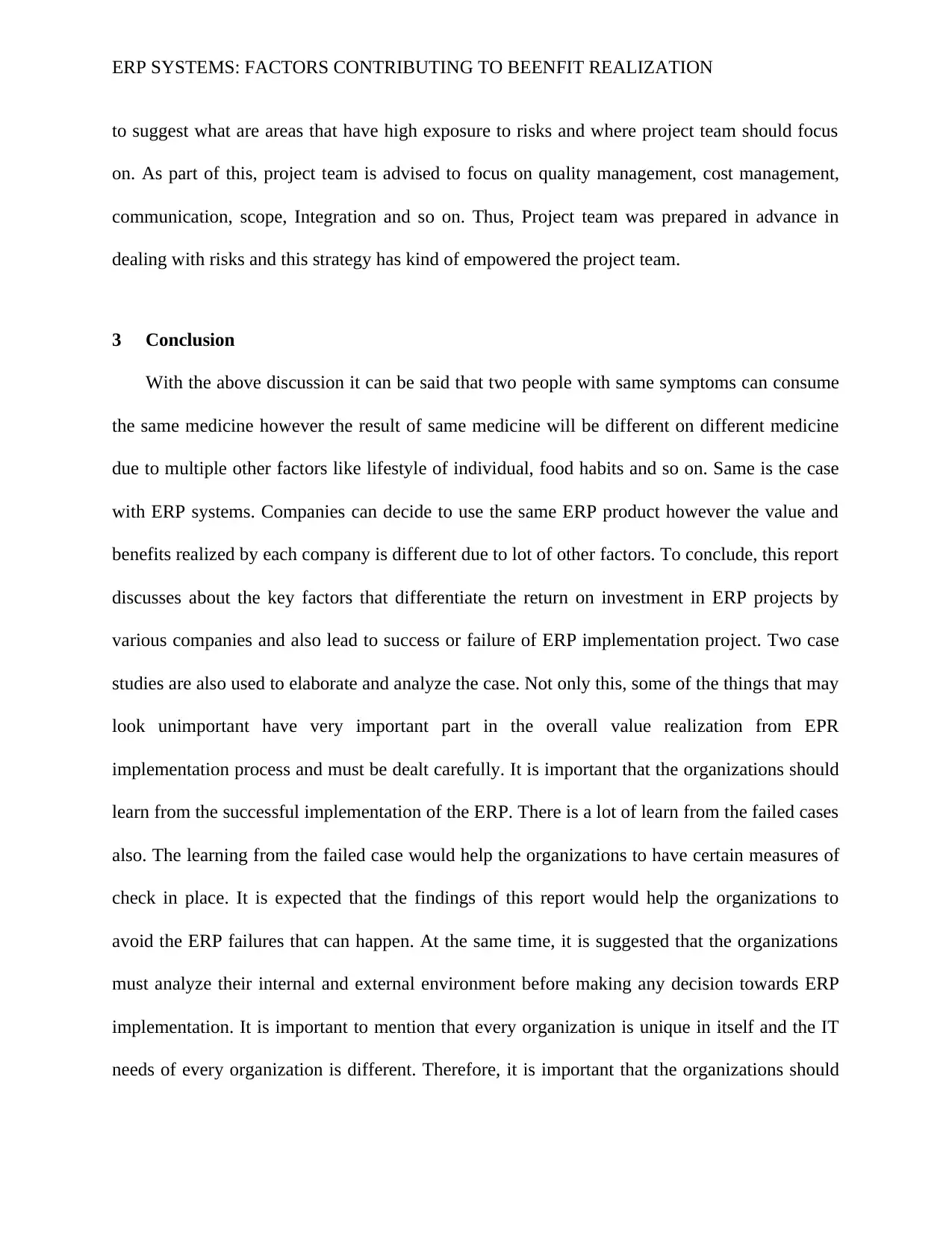
ERP SYSTEMS: FACTORS CONTRIBUTING TO BEENFIT REALIZATION
to suggest what are areas that have high exposure to risks and where project team should focus
on. As part of this, project team is advised to focus on quality management, cost management,
communication, scope, Integration and so on. Thus, Project team was prepared in advance in
dealing with risks and this strategy has kind of empowered the project team.
3 Conclusion
With the above discussion it can be said that two people with same symptoms can consume
the same medicine however the result of same medicine will be different on different medicine
due to multiple other factors like lifestyle of individual, food habits and so on. Same is the case
with ERP systems. Companies can decide to use the same ERP product however the value and
benefits realized by each company is different due to lot of other factors. To conclude, this report
discusses about the key factors that differentiate the return on investment in ERP projects by
various companies and also lead to success or failure of ERP implementation project. Two case
studies are also used to elaborate and analyze the case. Not only this, some of the things that may
look unimportant have very important part in the overall value realization from EPR
implementation process and must be dealt carefully. It is important that the organizations should
learn from the successful implementation of the ERP. There is a lot of learn from the failed cases
also. The learning from the failed case would help the organizations to have certain measures of
check in place. It is expected that the findings of this report would help the organizations to
avoid the ERP failures that can happen. At the same time, it is suggested that the organizations
must analyze their internal and external environment before making any decision towards ERP
implementation. It is important to mention that every organization is unique in itself and the IT
needs of every organization is different. Therefore, it is important that the organizations should
to suggest what are areas that have high exposure to risks and where project team should focus
on. As part of this, project team is advised to focus on quality management, cost management,
communication, scope, Integration and so on. Thus, Project team was prepared in advance in
dealing with risks and this strategy has kind of empowered the project team.
3 Conclusion
With the above discussion it can be said that two people with same symptoms can consume
the same medicine however the result of same medicine will be different on different medicine
due to multiple other factors like lifestyle of individual, food habits and so on. Same is the case
with ERP systems. Companies can decide to use the same ERP product however the value and
benefits realized by each company is different due to lot of other factors. To conclude, this report
discusses about the key factors that differentiate the return on investment in ERP projects by
various companies and also lead to success or failure of ERP implementation project. Two case
studies are also used to elaborate and analyze the case. Not only this, some of the things that may
look unimportant have very important part in the overall value realization from EPR
implementation process and must be dealt carefully. It is important that the organizations should
learn from the successful implementation of the ERP. There is a lot of learn from the failed cases
also. The learning from the failed case would help the organizations to have certain measures of
check in place. It is expected that the findings of this report would help the organizations to
avoid the ERP failures that can happen. At the same time, it is suggested that the organizations
must analyze their internal and external environment before making any decision towards ERP
implementation. It is important to mention that every organization is unique in itself and the IT
needs of every organization is different. Therefore, it is important that the organizations should

ERP SYSTEMS: FACTORS CONTRIBUTING TO BEENFIT REALIZATION
have customized strategies to implement the ERP in their environment. This would ensure that
the chances of failures are minimal and would ensure that organizations are able to get early
benefits from ERP implementation.
have customized strategies to implement the ERP in their environment. This would ensure that
the chances of failures are minimal and would ensure that organizations are able to get early
benefits from ERP implementation.
⊘ This is a preview!⊘
Do you want full access?
Subscribe today to unlock all pages.

Trusted by 1+ million students worldwide
1 out of 15
Related Documents
Your All-in-One AI-Powered Toolkit for Academic Success.
+13062052269
info@desklib.com
Available 24*7 on WhatsApp / Email
![[object Object]](/_next/static/media/star-bottom.7253800d.svg)
Unlock your academic potential
Copyright © 2020–2025 A2Z Services. All Rights Reserved. Developed and managed by ZUCOL.





